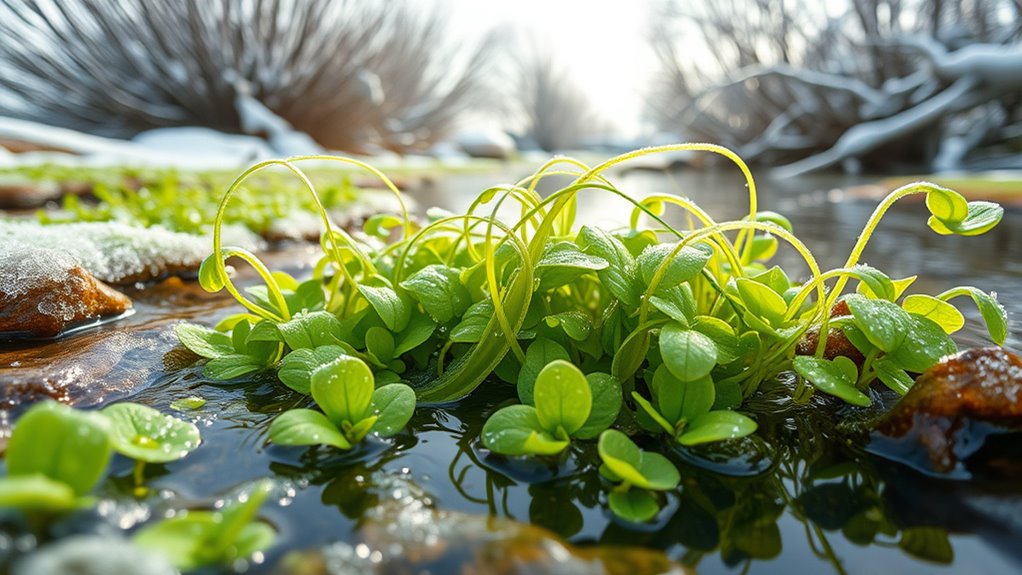To keep watercress safe and clean during winter, protect it from frost with cloches or fabric covers, and create a microclimate that maintains warmer temperatures. Use fresh, uncontaminated water sources, and regularly wash your harvest thoroughly to remove dirt and potential pollutants. Avoid stagnant water that can harbor bacteria. Following these practices helps make certain your winter watercress stays healthy, safe, and delicious—more tips await to help you master winter harvesting safely.
Key Takeaways
- Ensure watercress is sourced from safe, clean water sources free from pollutants and contaminants.
- Regularly test water quality to prevent bacterial risks like E. coli or other pathogens.
- Use frost protection measures to maintain plant health and prevent contamination from cold-related damage.
- Practice proper harvesting hygiene, washing watercress thoroughly to remove soil and environmental impurities.
- Store harvested watercress in clean, refrigerated conditions to maintain freshness and safety during winter.

Watercress remains a hardy and versatile green even during winter months, making it a valuable addition to your cold-season garden or kitchen. But to keep your watercress thriving and safe, you need to understand how to protect it from frost and master harvesting tips that preserve its freshness. Winter can be tough, but with the right strategies, you won’t just survive the season—you’ll flourish.
Frost protection is essential if you want your watercress to stay healthy through cold snaps. You can shield your plants with simple measures like cloches, row covers, or even a layer of straw mulch. These barriers trap heat and prevent frost from damaging the delicate leaves. If a sudden cold snap is forecasted, consider investing in lightweight fabric covers that can be quickly draped over your watercress. The goal is to create a microclimate that keeps the temperature just above freezing, giving your plants a fighting chance against winter’s chill. Remember, consistent protection is key—don’t leave your plants exposed during the coldest nights, and remove covers during the day to allow sunlight and air circulation.
Use cloches, row covers, or straw mulch to shield watercress from frost and maintain healthy growth.
When it comes to harvesting tips, timing is everything. Watercress grows quickly, so you’ll want to pick leaves regularly to encourage new growth and prevent the plant from becoming woody or bitter. The best time to harvest is when the leaves are tender and vibrant—usually about 2-3 inches long. Use sharp scissors or pruning shears to snip the stems just above the crown, leaving enough foliage so the plant can continue producing. Be gentle to avoid damaging the roots, which are essential for future harvests. For winter harvesting, do it early in the day when the leaves are crisp and fresh. Always wash your watercress thoroughly before using, especially during winter, when soil and environmental factors can introduce contaminants. This not only guarantees safety but also maintains the crunchiness you crave. Additionally, consider harvesting in a way that liberates your culinary creativity. Instead of taking all the watercress at once, pick small amounts regularly, giving your plants space to recover quickly. This sustainable approach means you’ll always have fresh greens on hand, even during the coldest months. Remember, your goal is to enjoy watercress’s peppery flavor and nutritional benefits all year round, without risking the health of your plants or your safety. So, prioritize frost protection and strategic harvesting tips, and you’ll turn winter into a season of abundance rather than struggle. With these simple steps, your watercress can be a resilient, invigorating part of your winter garden and kitchen adventure. Recognizing the importance of proper growth conditions ensures your watercress remains productive and safe during colder months.
Frequently Asked Questions
Is Watercress Safe to Eat During Winter Months?
Yes, watercress is safe to eat during winter months if you practice proper winter watering and understand its plant resilience. You can enjoy fresh watercress year-round by ensuring it gets enough water and protection from harsh conditions. With some care, your watercress will thrive, offering you vibrant, nutritious greens even in cold weather. Embrace winter gardening and savor the freedom of harvesting your own healthy, crisp watercress anytime.
How Do I Identify Clean Water Sources for Watercress?
Sure, finding pristine water for your watercress sounds like a quest for purity, but don’t trust just any stream. Instead, perform water quality testing or seek natural spring sources with clear, bubbling water, untouched by pollution. Liberate yourself from doubts by choosing water that’s naturally pure. Remember, clean water sources aren’t just easy to find—they’re your key to thriving, safe watercress all year round.
Can Watercress Be Harvested From Frozen Water?
You can harvest watercress from frozen water, but do so carefully. Frozen water harvesting allows you to access watercress even during frost, leveraging its frost tolerance. When the water is frozen, gently loosen the watercress without damaging its delicate stems. Remember, avoid harvesting from ice-covered or contaminated sources to stay safe and ensure your watercress remains clean and healthy. Embrace winter harvesting and enjoy fresh greens year-round!
Are There Any Winter-Specific Watercress Pests or Diseases?
A bird in the hand is worth two in the bush, and in winter, you must stay vigilant. Winter pests like aphids and slugs can still threaten your watercress, while cold diseases like downy mildew and root rot lurk in damp conditions. You can fight back by maintaining clean water sources and protecting plants with cold-resistant covers. Stay proactive, and you’ll keep your watercress thriving through winter’s chill.
How Long Can Watercress Be Stored After Winter Harvesting?
You can store watercress for up to a week after winter harvesting if you use proper preservation methods. To maximize freshness, rinse it gently, then store it in a plastic bag or airtight container in the refrigerator. Keep it moist with a damp paper towel. This way, you maintain its crispness and flavor longer, giving you the freedom to enjoy your watercress even days after harvest.
Conclusion
As winter settles in, remember that your watercress’s health depends on safe, clean water sources. Don’t let hidden dangers sneak in—think of your watercress as a precious gem that needs pure water to shine. By ensuring proper sourcing and safety measures, you protect both your crop and your health. So, be vigilant; after all, isn’t your well-being worth the extra effort? Keep your watercress thriving through winter’s chill!










